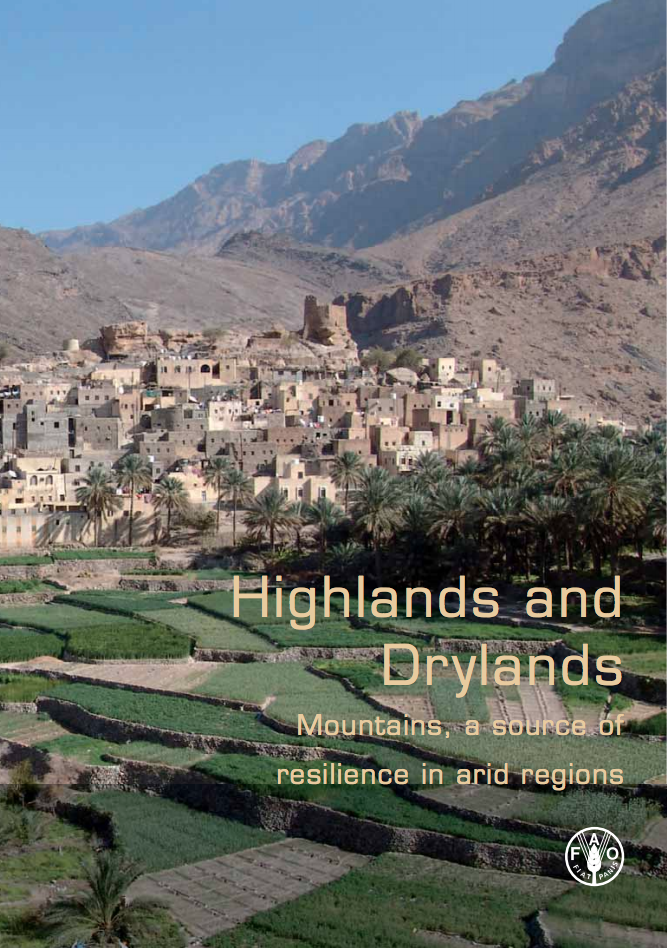Resource information
Non-commercial uses will be authorized free of charge, upon request. Reproduction for resale or other
commercial purposes, including educational purposes, may incur fees. Applications for permission to reproduce
or disseminate FAO copyright materials, and all queries concerning rights and licenses, should be addressed by
e-mail to copyright@fao.org or to the Chief, Publishing Policy and Support Branch, Office of Knowledge
Exchange, Research and Extension, FAO, Viale delle Terme di Caracalla, 00153 Rome, Italy.
Dryland mountains are among the least-known environments in the world, and certainly one of the most overlooked by decision- and policy-makers.
Dryland mountains have an outstanding strategic value. They act as water towers for surrounding dry lowland areas, as shown by the examples of the Rocky Mountains of North America, the Central Andes, the mountains of the Mediterranean Basin, the Sahara and Sub-Saharan Africa, West Asia, and Central Asia
Drylands are home to more than 2 billion people – about 35% of the human population on Earth – and have some of the highest levels of poverty (47%). Although dryland mountains are often sparsely populated – with 296 million inhabitants globally – millions of people living in lowland areas depend on the water and other environmental services generated within these mountains. Global changes in these mountains will not only affect mountain dwellers, but also the livelihoods and welfare of a considerable portion of humanity.
Over the past millennia, the ecological and social systems in dryland mountain regions have developed very successful strategies to withstand a number of environmental stresses including water scarcity – the main limiting factor to life. The adaptive knowledge and skill of dryland mountain people are increasingly recognised as key tools for coping with current and forecasted changes in climate – namely the exacerbation of extreme weather events. Dryland mountains may well become global change laboratories for monitoring the combined effects of climate and socio-economic changes, assessing the effectiveness of adaptation options, and proposing responses at local, regional and global scale.
The majority of dryland mountain regions are outstanding in terms of biodiversity, but this extraordinary wealth is critically endangered by threats such as the overexploitation of natural resources, land conversion into unsustainable land uses, altered hydrologic and fire regimes, pollution, unsustainable population densities, armed conflicts, and the invasion of exotic species leading to desertification processes. This explains why dryland mountains are considered a priority area of work for the implementation of the United Nations Convention to Combat Desertification (UNCCD) and the Convention on Biological Diversity (CBD).
In the light of knowledge gaps and the lack of awareness of and attention given to dryland mountains, and as part of its activities to support sustainable mountain development, sustainable forestry and combat desertification in drylands, The Food and Agriculture Organization of the United Nations (FAO) together with key partners such as the Mountain Partnership Secretariat, the UNCCD Secretariat, the Centre for Development and Environment of the University of Bern and the Swiss Agency for Development and Cooperation, identified an urgent need to prepare this publication in order to:
- Provide an overall vision of the ecological, social and cultural features of dryland mountain socio-ecosystems, highlighting those processes and elements which have determined their resilience to past and present disturbances, describing current and future impacts, and offering a perspective on conservation and sustainable development based on successful examples from all regions of the world.
- Raise the awareness of development experts, donors and policy and decision makers about the relevance, extent, main challenges, solutions and good practices developed to address desertification and development issues in dryland mountain ecosystems worldwide.
The ultimate objective is to demonstrate the importance of investing human and financial resources in dryland mountains in the framework of the global effort to limit the impact of global change on the livelihoods of human societies and on the natural and cultural wealth of our planet.


